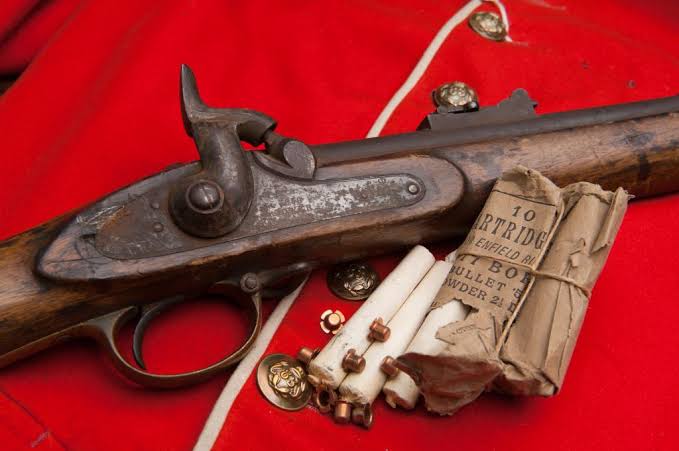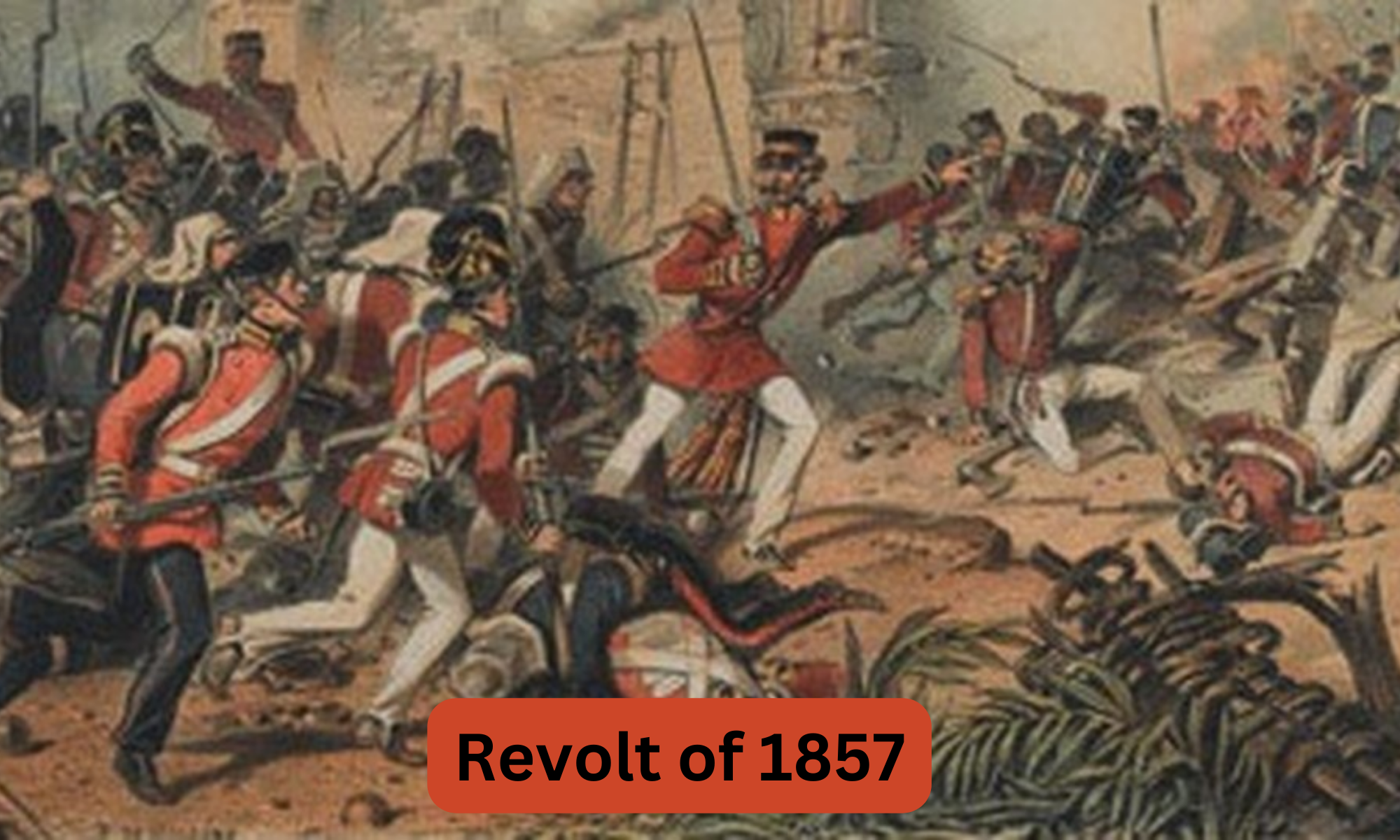Table of Contents
Revolt of 1857
The British East India Company, which served as the sovereign power in India on behalf of the British Crown, was the target of a significant revolt in 1857–1858 known as the Indian Rebellion of 1857 or the Revolt of 1857. In the garrison town of Meerut, 64 kilometres northeast of Delhi, sepoys of the Company’s army staged a mutiny on May 10, 1857, signalling the start of the uprising.
Afterwards, it burst into other mutinies and civil uprisings, primarily in central India and the upper Gangetic plain, though there were also instances of uprising further north and east. Only the rebels’ loss in Gwalior on June 20, 1858, was able to put an end to the uprising, which constituted a military threat to British dominance in that area.
The British declared the hostilities to have officially ended on 8 July 1859, but they had already offered amnesty to all rebels who had not committed murder on 1 November 1858. The First War of Independence, the Great Rebellion, the Revolt of 1857, the Sepoy Mutiny, the Indian Mutiny, and other names have all been used to refer to it.
Reason of Revolt of 1857
Resentments stemming from a variety of perceptions, such as intrusive British-style social reforms, severe land taxes, the shabby treatment of some wealthy landowners and princes, as well as scepticism regarding the advancements brought about by British rule, fed the Indian insurrection. Although many Indians rebelled against the British, many others also battled in their favour, and the majority appeared to continue to submit to British rule. Fighting and British vengeance left the towns of Delhi and Lucknow in ruins, and both sides inflicted violence that occasionally revealed extraordinary cruelty on British officers, civilians, including women and children, and rebels and their sympathisers, sometimes even entire villages.
Causes of the 1857 Rebellion
Instead of being caused by a single event, the Indian Rebellion of 1857 was the consequence of a number of causes coming together over time.
- Indian soldiers known as “sepoys” were enlisted into the Company’s armed forces. In the army just prior to the uprising, there were more than 300,000 sepoys as opposed to roughly 50,000 British.
- The mutinies that started the insurrection have been partially attributed to the dominance of higher castes in the Bengal Army.
- Moreover, Company took steps to modify its military procedures to meet the needs of their religious rites. These troops dined in separate facilities as a result; in addition, they were exempt from overseas service because it was viewed as demeaning to their caste; and eventually, the army started to formally recognise Hindu holidays.
- Once the East India Company annexed Oudh (Awadh) in 1856, many sepoys were uneasy about losing their privileges as landed gentry in the Oudh courts as well as the possibility of higher land-revenue payments as a result of the annexation.
- Some historians have emphasised that by 1857, several Indian soldiers were convinced that the Company was orchestrating the widespread conversion of Hindus and Muslims to Christianity because they saw the presence of missionaries as an indication of official purpose.
- The General Service Enlistment Act on July 25, 1856 was a significant source of resentment that developed ten months prior to the start of the uprising.

The new Enfield Pattern 1853 rifled musket’s ammo lit the final match. These weapons, which employed pre-greased paper cartridges and Minié balls, had a tighter fit than the previous muskets. Sepoys had to bite open the cartridge to liberate the powder in order to load the gun. It was rumoured that the grease used on these cartridges contained lard made from pork, which would offend Muslims, and tallow made from cattle, which would offend Hindus.
The Onset of Revolt
The insurrection itself was preceded by months of rising tensions and many occurrences. The new cartridges the 19th Bengal Native Infantry unit had been given were wrapped in paper coated with cow and pig fat, which had to be opened by mouth and offended their religious sensibilities. This worry arose on February 26, 1857. The next morning’s procession was cancelled after their colonel confronted them while being supported by cavalry and artillery on the parade grounds.
Mangal Pandey
Due to the previous activities of the East India Company, Mangal Pandey, a 29-year-old member of the 34th BNI, stated his intention to rebel against his superiors on March 29, 1857, at the Barrackpore parade ground, close to Kolkata. Sergeant-Major James Hewson went to investigate after learning of Pandey’s behaviour, but Pandey shot at him. On April 6, he was court-martialed, and two days later, he was executed.
The regiment was disbanded and deprived of its uniforms because it was thought that, especially following this episode, it harboured animosity towards its leaders.
These penalties were viewed as draconian by sepoys in other regiments. Several historians believe that the display of dishonour during the ceremonial disbanding contributed to the insurrection. Disgruntled ex-sepoys sought retribution upon their return to Awadh.

Revolt of 1857: Important Indian Leaders
Place |
Indian Leader |
| Delhi | Bahadur Shah II, General Bakht Khan |
| Lucknow | Begum Hazrat Mahal, Birjis Qadir, Ahmadullah |
| Rajasthan | Jaidayal Singh and Hardayal Singh |
| Farrukhabad | Tufzal Hasan Khan |
| Assam | Kandapareshwar Singh, Maniram Dutta Baruah |
| Kanpur | Nana Sahib, Rao Sahib, Tantia Tope, Azimullah Khan |
| Jhansi | Rani Laxmibai |
| Bihar | Kunwar Singh, Amar Singh |
| Orissa | Surendra Shahi, Ujjwal Shahi |
Ending the Revolt of 1857
As the revolt in Meerut started, the rebels moved swiftly to Delhi, where Bahadur Shah Zafar, an 81-year-old Mughal emperor, was proclaimed the Emperor of Hindustan. Shortly, the rebels had seized vast portions of Awadh and the North-Western Provinces (Oudh). The reaction from the East India Company also came quickly. Kanpur was retaken by mid-July 1857, and Delhi by the end of September, both with the aid of troops. But it took till the latter half of 1857 and the first half of 1858 to put an end to the uprising in Jhansi, Lucknow, and particularly the Awadh region.
Consequences of Revolt of 1857
- According to some estimates, 100,000 of the 150,000 Indians slain during the conflict in Oudh alone were civilians.
- Massacres took place all over the country after British forces took control of Delhi, Allahabad, Kanpur, and Lucknow.
- General Neill committed a further horrific act by massacring hundreds of Indian civilians and mutineers who were thought to be helping the uprising.
- Many British soldiers were incensed and wanting revenge after learning of the rebels’ slaughter of British women, children, and injured soldiers at Cawnpore and the subsequent publication of the atrocities in British newspapers.
- In addition to hanging mutinous individuals, the British also employed the practise of “blowing from cannon,” which involved tying convicted rebels over cannon mouths and having them explode when the cannons were fired.
- A particularly horrific British military action at Cawnpore was making several Muslim or Hindu rebels consume pork or meat and licking structures that had just been covered with blood before following public hangings.
Aftermath of Revolt of 1857
- As a means of revenge against the revolt, British soldiers also perpetrated sexual abuse against Indian women.
- The British soldiers exacted retribution on Indian citizens by perpetrating atrocities and rapes against Indian women as towns and cities were taken from the sepoys.
- The British had started to gain ground again by the end of 1857. It took place again in March 1858.
- The uprising came to an end on July 8th, 1858, when a peace deal was signed.
- On June 20, 1858, the remaining rebels were put down in Gwalior.
- Rebel leaders Bakht Khan and Nana Sahib were either dead or had fled by 1859.
The Bombay Presidency, the Madras Presidency, and other Company-controlled areas of India remained generally tranquil. The Sikh princes played a vital role in aiding the British in the Punjab by supplying both soldiers and assistance. The larger princely realms of Hyderabad, Mysore, Kashmir, and Travancore, as well as the lesser ones of Rajputana, resisted the British, acting as “breakwaters in a storm,” in the words of Governor-General Lord Canning.
End of East India Company Rule in India
Several areas of the insurrection, most notably in Awadh, adopted the characteristics of a patriotic uprising against British authority. However, none of the rebel leaders’ declarations hinted to a new political order. Despite yet, the uprising turned out to be a significant turning point in the histories of the British Empire and India. By passing the Government of India Act 1858, it required the British to restructure the army, the financial system, and the administration in India, which resulted in the breakup of the East India Company.
Start of British Rule in India
The British government then took direct control of India under the new British Raj. Despite not having the legal standing of a constitutional clause, Queen Victoria guaranteed Indians on November 1st a set of rights that were comparable to those enjoyed by other British subjects. As these rights were not always recognised in the next decades, Indians were to specifically cite the Queen’s proclamation in their expanding declarations of a new nationalism.
Causes of Failure of the revolt of 1857
Due to a number of causes, the revolution ultimately failed to drive the British out of the country.
- There was more than one obvious leader among the sepoys. Also, they lacked a clear strategy for how to get the foreigners to their destination.
- Indian sultans who supported the uprising had no plans for their nation after the British were driven out.
- This uprising mostly affected northern India. Most of the three presidencies—Bangladesh, Bombay, and Madras—were unaffected.



 TSPSC Group 1 Question Paper 2024, Downl...
TSPSC Group 1 Question Paper 2024, Downl...
 TSPSC Group 1 Answer key 2024 Out, Downl...
TSPSC Group 1 Answer key 2024 Out, Downl...
 UPSC Prelims 2024 Question Paper, Downlo...
UPSC Prelims 2024 Question Paper, Downlo...





